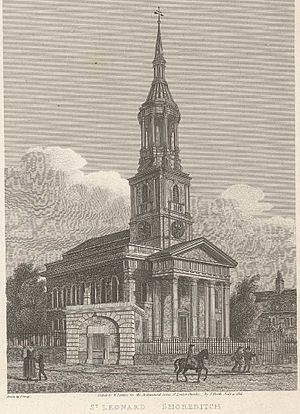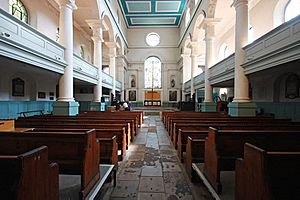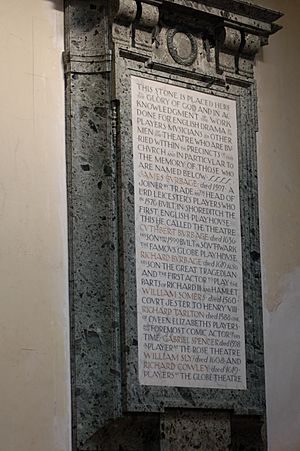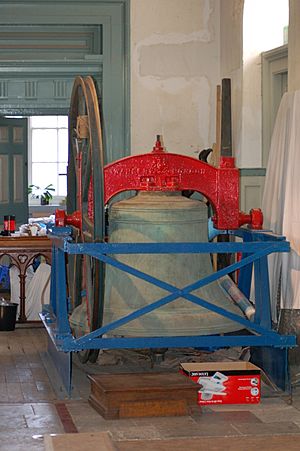St Leonard's, Shoreditch facts for kids
Quick facts for kids St Leonard's, Shoreditch |
|
|---|---|

18th-century print of St Leonard's
|
|
| Location | London Borough of Hackney |
| Country | United Kingdom |
| Denomination | Church of England |
| Architecture | |
| Architect(s) | George Dance the Elder |
| Style | Palladian |
| Years built | 1740 |
| Administration | |
| Diocese | London |
St Leonard's, Shoreditch, often called Shoreditch Church, is a very old church in Shoreditch, East London. You can find it where Shoreditch High Street meets Hackney Road, in the London Borough of Hackney. The building you see today was built around 1740. It is a Grade I listed building, which means it's very important historically. The church is famous for being mentioned in the nursery rhyme Oranges and Lemons with the line: "'When I grow rich', say the bells of Shoreditch".
Many actors from the Tudor period are buried in the crypt (an underground room) beneath the church.
Contents
A Look Back: The Church's History
The first church here might have been built during the Anglo-Saxon period. We know for sure it existed by the 12th century.
This church was very close to England's first special playhouses. These included The Theatre, built in 1576, and the Curtain Theatre, built in 1577. Because of this, many famous actors from the time of Queen Elizabeth I are buried here. Some of them include:
- James Burbage: He started The Theatre, which was England's first building made just for plays.
- Richard Burbage: James's son, he was the main actor in many of Shakespeare's plays. These plays were first performed in the Shoreditch theaters nearby.
- Richard Tarlton: A well-known comedian from before Shakespeare's time.
- Gabriel Spenser: An actor who was sadly killed in a duel by the writer Ben Jonson.
A large memorial was put up inside the church in 1913. It remembers these actors and shows how important Shoreditch was to Shakespeare's time.
In 1774, the people of Shoreditch set up a workhouse for the poor. This shows that there were many people in need in the area back then.
The Church Building Today
The old medieval church had problems, and part of its tower fell down in 1716. So, a new church was built between 1736 and 1740. George Dance the Elder designed it in the Palladian style. This style is known for its grand, balanced look, like old Roman temples.
The church has a very tall steeple, reaching 192 feet high. It looks a bit like the famous steeple on St Mary-le-Bow church. The front of the church has a large portico with four big columns. Inside, you can see huge columns supporting the ceiling. George Dance the Elder also designed the Mansion House in London.
Many of the church's original items from the 1700s are still there. These include the font (for baptisms), the pulpit (where sermons are given), the communion table, and the clock. In 1817, it became the first church in London to be lit by gaslight.
In the church porch, you can still see the old stocks and whipping post. These were tools used for punishment a long time ago. The old Shoreditch parish pump is also in the churchyard.
Church Bells
The church has had bells for many centuries, which is why it's in the Oranges and Lemons rhyme. The current set of 12 bells was made in 1994 by John Taylor & Co in Loughborough. These bells are used for change ringing, a special way of ringing bells in a pattern.
The bells of St Leonard's are so important that they are even shown on the coat of arms of the London Borough of Hackney.
Old Organs
The church has two organs. One is a very old tracker organ built by Richard Bridge in 1756. It still has its original wooden pipes and is special because it doesn't have pedals. This old organ needs to be fixed up.
The church also has a modern electric organ. This one is used regularly for church services, concerts, and even for recording music. For example, it was used in the Serafina Steer album The Moths Are Real.
Featured in TV Shows
St Leonard's Church has appeared in a few TV shows:
- From 2010 to 2014, it was used as a fictional church called St Saviour in the Marshes in the BBC comedy series Rev..
- In 2011, the church was seen in the second season of the TV series Luther.
Notable People Connected to the Church
Many interesting people have been connected to St Leonard's Church over the years:
- James Parkinson (1755–1824): He lived nearby and is the doctor after whom Parkinson's disease is named. There's a stone tablet for him inside the church, and his grave is in the churchyard.
- William Lewin: An important churchman and member of parliament during the time of Queen Elizabeth I. He was buried here in 1598.
- John George Appold (1800–1865): A scientist who helped invent the centrifugal pump. He has a stone tablet inside the church.
- Samuel Annesley (1620–1696): A famous nonconformist minister. He was the father of Susanna Wesley and the grandfather of John and Charles Wesley, who started the Methodist movement. He is buried in the churchyard.
- Thomas Fairchild (1667–1724): A pioneer gardener and writer. He set up a special yearly sermon at the church about God's creation or the resurrection. These talks were known as "The Vegetable Sermon" and continued until the 1990s.
- Thomas Legh (?1511-1545): A diplomat from the Tudor period, also buried here.
- Katherine Stafford: The wife of Ralph Neville, 4th Earl of Westmorland, is buried here.
- Johannes Banfi Hunyades: A Hungarian alchemist. Two of his children, Johannes (1621–1696) and Elizabeth (1620–1710), have large graves in the church crypt.
See also
 In Spanish: Iglesia de Shoreditch para niños
In Spanish: Iglesia de Shoreditch para niños
- List of churches in London
- The Clerk's House, a building that used to watch over the church's cemetery.




